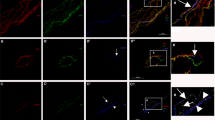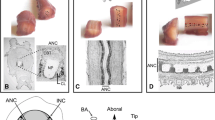Summary
Non-hairy and hairy human skin were investigated with the use of the indirect immunohistochemical technique employing antisera to different neuronal and non-neuronal structural proteins and neurotransmitter candidates. Fibers immunoreactive to antisera against neurofilaments, neuron-specific enolase, myelin basic protein, protein S-100, substance P, neurokinin A, neuropeptide Y, tyrosine hydroxylase and vasoactive intestinal polypeptide (VIP) were detected in the skin with specific distributional patterns. Neurofilament-, neuron-specific enolase-, myelin basic protein-, protein S-100-, substance P-, neurokinin A-and vasoactive intestinal polypeptide (VIP)-like immunoreactivities were found in or in association with sensory nerves; moreover, neuron-specific enolase-, myelin basic protein-, protein S-100, neuropeptide Y-, tyrosine hydroxylase- and vasoactive intestinal polypeptide (VIP)-like immunoreactivities occurred in or in association with autonomic nerves. It was concluded that antiserum against neurofilaments labels sensory nerve fibers exclusively, whereas neuron-specific enolase-, myelin basic protein- and protein S-100-like immunoreactivities are found in or in association with both sensory and autonomic nerves. Substance P- and neurokinin A-like immunoreactivities were observed only in sensory nerve fibers, and neuropeptide Y- and tyrosine hydroxylase-like immunoreactivities occurred only in autonomic nerve fibers, whereas vasoactive intestinal polypeptide (VIP)-like immunoreactivity was seen predominantly in autonomic nerves, but also in some sensory nerve fibers.
Similar content being viewed by others
References
Arthur RB, Shelly WB (1959) The innervation of human epidermis. J Invest Dermatol 32:397–441
Bishop AE, Polak JM, Facer P, Ferri G-L, Marangos PJ, Pearse AGE (1982) Neuron specific enolase: a common marker for the endocrine cells and innervation of the gut and pancreas. Gastroenterology 83:902–915
Björklund H, Dahl D, Seiger Å (1984) Neurofilament and glial fibrillary acidic protein-related immunoreactivity in rodent enteric nervous system. Neuroscience 12:277–287
Bock E (1978) Nervous system specific proteins. J Neurochem 30:7–14
Cauna N (1956) Nerve supply and nerve endings in Meissner's corpuscles. Am J Anat 99:315–350
Cauna N (1980) Fine morphological characteristics and microtopography of the free nerve endings of the human digital skin. Anat Rec 198:643–656
Coons AH (1958) Fluorescent antibody methods. In JF Danielli (ed) General cytochemical methods. Academic Press, New York, pp 399–422
Dahl D, Bignami A (1977) Preparation of antisera to neurofilament protein from chicken brain and human sciatic nerve. J Comp Neurol 176:645–658
Dahl D, Bignami A, Bich NT, Chi NH (1981) Immunohistochemical localization of the 150 K neurofilament protein in the rat and the rabbit. J Comp Neurol 195:659–666
Dalsgaard C-J, Jonsson C-E, Hökfelt T, Cuello AC (1983) Localization of substance P-immunoreactive nerve fibers in the human digital skin. Experientia 39:1018–1020
Dalsgaard C-J, Björklund H, Jonsson C-E, Hermansson A, Dahl D (1984) Distribution of neurofilament-immunoreactive nerve fibers in human digital skin. Histochemistry 81:111–114
Dalsgaard C-J, Haegerstrand A, Brodin E, Theodorsson-Norheim E, Hökfelt T (1985) Neurokinin A-like immunoreactivity in rat primary sensory neurons: coexistence with substance P. Histochemistry (in press)
Erspamer V (1981) The tachykinin peptide family. Trends Neurosci 4:267–269
Falck B (1962) Observation on the possibility of the cellular localization of monoamines by a fluorescence method. Acta Physiol Scand 56 (Suppl 56):1–25
Ferri G-L, Probert L, Cocchia D, Michetti F, Marangos PJ, Polak JM (1982) Evidence for the presence of S-100 protein in the glial component of the human enteric nervous system. Nature 297:409–410
Hoffman PN, Lasek RL (1975) The slow component of axonal transport. Identification of major structural polypeptides of the axon and their generality among mammalian neurons. J Cell Biol 66:351–366
Hökfelt T, Kellerth J-O, Nilsson G, Pernow B (1975) Experimental immunohistochemical studies on the localization and distribution of substance P in cat primary sensory neurons. Brain Res 100:235–252
Itoyama Y, Sternberger NH, Kies UW, Cohen SR, Richardson EP, Webster HF (1980) Immunocytochemical method to identify myelin basic protein in oligodendroglia and myelin sheaths of the human nervous system. Ann Neurol 7:157–166
Iwanaga T, Fujita T, Takahashi Y, Nakajima T (1982) Meissner's and Pacinian corpuscles as studied by immunohistochemistry for S-100 protein, neuron-specific enolase and neurofilament protein. Neurosci Lett 31:117–121
Kanagava K, Minamino M, Fukuda A, Matsuo H (1983) Neuromedin K identified in porcine spinal cord. Biochem Biophys Res Commun 111:533–540
Kato K, Ishiguro Y, Suruki F, Ito A, Semba R (1982) Distribution of nervous system-specific forms of enolase in peripheral tissues. Brain Res 237:441–448
Kimura S, Okada N, Sugita Y, Kanazawa I, Munekata E (1983) Novel neuropeptides: neurokinin α and β isolated from porcine spinal cord. Proc Jpn Acad 59:101–104
Koelle GB (1963) Cytological distribution and physiological functions of cholinesterases. In GB Koelle (ed) Cholinesterases and Anticholinesterase Agents (Handbuch der experimentellen Pharmakologie) Springer-Verlag Berlin, p 187
Lazarides E (1980) Intermediate filaments as mechanical integrators of cellular space. Nature 283:249–256
Ludwin SK, Kosek JC, Eng LF (1976) The topographical distribution of S-100 and GFA proteins in the adult rat brain: an immunohistochemical study using horseradish peroxidase-labelled antibodies. J Comp Neurol 165:197–208
Lundberg JM, Hökfelt T, Schultzberg M, Norell G, Nilsson G, Uvnäs-Wallensten K, Terenius L, Dahlström A, Rehfeld JF, Elde R, Said S (1978) Peptide neurons in the vagus, splanchnic and sciatic nerves. Acta Physiol Scand 104:449–501
Lundberg JM, Hökfelt T, Schultzberg M, Uvnäs-Wallensten K, Köhler C, Said S (1979) Occurrence of vasoactive intestinal polypeptide (VIP)-like immunoreactivity in certain cholinergic neurons of the cat: Evidence from combined immunohistochemstry and acethylcholinesterase staining. Neuroscience 4:1539–1559
Lundberg JM, Terenius L, Hökfelt T, Martling CR, Tatemoto K, Mutt V, Polak J, Bloom S, Goldstein M (1981) Neuropeptide Y (NPY)-like immunoreactivity in peripheral noradrenergic neurons and effects of NPY on sympathetic function. Acta Physiol Scand 116:477–480
Lundberg JM, Terenius L, Hökfelt T, Goldstein M (1983) High levels of neuropeptide Y in peripheral neurons in various mammals including man. Neurosci Lett 42:167–172
Miller MR, Ralston HJ, Kasahara M (1958) The pattern of cutaneous innervation of the human hand. Am J Anat 102:183–218
Minamino N, Kangava K, Fukuda A, Matsuo H (1984) Neuromedin L: a novel mammalian tachykinin identified in porcine spinal cord. Neuropeptides 4:157–164
Moore BW (1965) A soluble protein characteristic of the nervous system. Biochem Biophys Res Commun 19:739–744
Moore BW, Mc Gregor D (1965) Chromatographic and electrophoretic fractionation of soluble proteins of brain and liver. J Biol Chem 240:1647–1653
Nawa H, Hirose T, Takashima H, Inayama S (1983) Nucleotide sequence of cloned cDNA for two types of bovine brain substance P precursors. Nature (Lond) 306:32–36
Papka RE, Furness JB, Della NG, Costa M (1981) Depletion by capsaicin of substance P-immunoreactivity and acetylcholinesterase activity in the guinea pig heart. Neurosci Lett 27:47–53
Pernow B (1983) Substance P. Pharmacol Rew 35:85–141
Pickel VM, Reis DJ, Marangos PJ, Zomzely Neurath C (1976) Immunocytochemical localization of nervous system specific protein (NSP-R) in rat brain. Brain Res 105:184–187
Rausch HC, Raffel S (1964) Immunofluorescence localization of encephalitogenic protein in myelin. J Immunol 92:452–455
Said SI, Mutt V (1970) Polypeptide with broad biological activity: isolation from small intestine. Science 169:1217–1218
Schlaepfer WW (1977) Immunological and ultrastructural studies of neurofilaments isolated from rat peripheral nerve. J Cell Biol 74:226–240
Schlaepfer WW, Lynch RG (1977) Immunofluorescence studies of neurofilaments in the rat and human peripheral and central nervous system. J Cell Biol 74:241–250
Schmechel DE, Marangos PJ, Brightman M (1978) Neuron-specific enolase is a molecular marker for peripheral and central neuroendocrine cells. Nature (Lond) 276:834–836
Seiger Å, Dahl D, Ayer-Le Lievre C, Björklund H (1984) Appearance and distribution of neurofilament immunoreactivity in iris nerves. J Comp Neurol 223:457–470
Shaw G, Osborn M, Weber K (1981) An immunofluorescence microscopical study of the neurofilament triplet proteins, vimentin and glial fibrillary acidic protein within the adult rat brain. Eur J Cell Biol 26:68–82
Stefansson KR, Wollman L, Moore BW (1982) Distribution of S-100 protein outside the central nervous system. Brain Res 234:309–317
Tatemoto K (1982) Neuropeptide Y: the complete amino acid sequence of the brain peptide. Proc Natl Acad Sci, USA 79:5485–5489
Tatemoto K, Carlquist M, Mutt V (1982) Neuropeptide Y — a novel brain peptide with structural similarities for peptide YY and pancreatic polypeptide. Nature (Lond) 296:659–660
Watabe K, Kumaniski T, Ikuta F, Ogate (1983) Tactile-like corpuscles in neurofibromas. Immunohistochemical demonstration of S-100 protein. Acta Neuropathol (Berl) 61:173–177
Author information
Authors and Affiliations
Rights and permissions
About this article
Cite this article
Björklund, H., Dalsgaard, C.J., Jonsson, C.E. et al. Sensory and autonomic innervation of non-hairy and hairy human skin. Cell Tissue Res. 243, 51–57 (1986). https://doi.org/10.1007/BF00221851
Accepted:
Issue Date:
DOI: https://doi.org/10.1007/BF00221851




